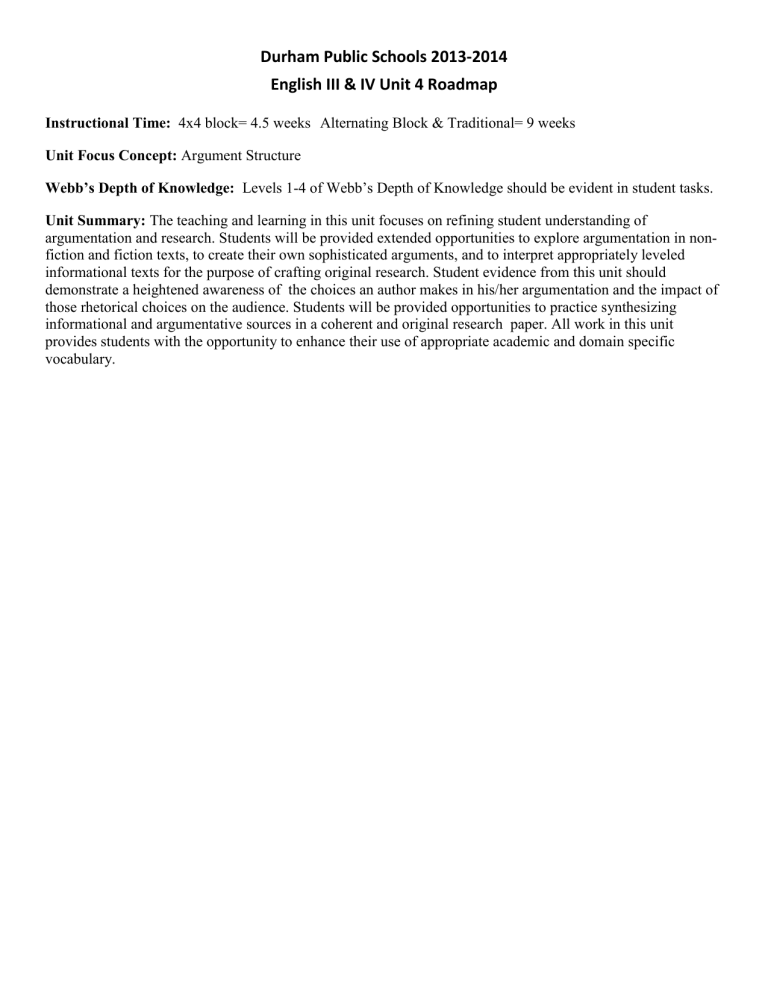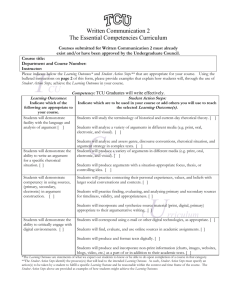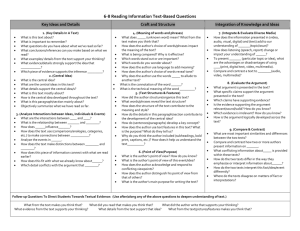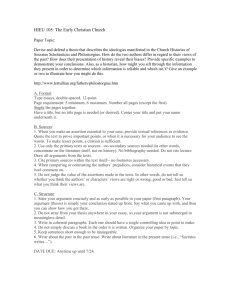Unit 4 Roadmap English III and IV

Durham Public Schools 2013-2014
English III & IV Unit 4 Roadmap
Instructional Time: 4x4 block= 4.5 weeks Alternating Block & Traditional= 9 weeks
Unit Focus Concept: Argument Structure
Webb’s Depth of Knowledge: Levels 1-4 of Webb’s Depth of Knowledge should be evident in student tasks.
Unit Summary: The teaching and learning in this unit focuses on refining student understanding of argumentation and research. Students will be provided extended opportunities to explore argumentation in nonfiction and fiction texts, to create their own sophisticated arguments, and to interpret appropriately leveled informational texts for the purpose of crafting original research. Student evidence from this unit should demonstrate a heightened awareness of the choices an author makes in his/her argumentation and the impact of those rhetorical choices on the audience. Students will be provided opportunities to practice synthesizing informational and argumentative sources in a coherent and original research paper. All work in this unit provides students with the opportunity to enhance their use of appropriate academic and domain specific vocabulary.
Durham Public Schools 2013-2014
English III & IV Unit 4 Roadmap
Common Core State Standards for Literacy in English Language Arts Grades 9-10
* Bold text indicates the skill progression contained in that standard for grades 9-10.
Reading: Informational Texts
1. Cite strong and thorough textual evidence to support analysis of what the text says explicitly as well as inferences drawn from the text, including determining where the text leaves matters uncertain.
3. Analyze a complex set of ideas or sequence of events and explain how specific individuals, ideas, or events interact and develop over the course of the text.
Reading: Literature
1.
Cite strong and thorough textual evidence to support analysis of what the text says explicitly as well as inferences drawn from the text, including determining where the text leaves matters uncertain.
3. Analyze the impact of the author’s choices regarding how to develop and relate elements of a story or drama (e.g., where a story is set, how the action is ordered, how the characters are introduced and developed).
5. Analyze and evaluate the effectiveness of the structure an author uses in his or her exposition or argument, including whether the structure makes points clear, convincing, and engaging.
6. Determine an author’s point of view or purpose in a text in which the rhetoric is particularly effective, analyzing how style and content contribute to the power, persuasiveness or beauty of the text.
7.
Integrate and evaluate multiple sources of information presented in different media or formats (e.g., visually, quantitatively) as well as in words in order to address a question or solve a problem.
8. Delineate and evaluate the reasoning in seminal U.S. texts, including the application of constitutional principles and use of legal reasoning (e.g., in U.S. Supreme Court majority opinions and dissents) and the premises, purposes, and arguments in works of public advocacy
(e.g., The Federalist, presidential addresses).
5. Analyze how an author’s choices concerning how to structure specific parts of a text (e.g., the choice of where to begin or end a story, the choice to provide a comedic or tragic resolution) contribute to its overall structure and meaning as well as its aesthetic impact.
6. Analyze a case in which grasping a point of view requires distinguishing what is directly stated in a text from what is really meant (e.g., satire, sarcasm, irony, or understatement).
7. Analyze multiple interpretations of a story, drama, or poem (e.g., recorded or live production of a play or recorded novel or poetry), evaluating how each version interprets the source text.
(Include at least one play by Shakespeare and one play by an American dramatist.)
9.
Demonstrate knowledge of eighteenth-, nineteenth- and early-twentieth-century foundational works of American literature, including how two or more texts from the same period treat similar themes or topics.
9.
Analyze seventeenth-, eighteenth-, and nineteenthcentury foundational U.S. documents of historical and literary significance (including The Declaration of
Independence, the Preamble to the Constitution, the Bill of Rights, and Lincoln’s Second Inaugural Address) for their themes, purposes, and rhetorical features.
Writing
1.
Write arguments to support claims in an analysis of substantive topics or texts, using valid reasoning and relevant and sufficient evidence.
2.
Write informative/ explanatory texts to examine and convey complex ideas, concepts, and information clearly and accurately through the effective selection, organization, and analysis of content.
Speaking & Listening
3. Evaluate a speaker’s point of view, reasoning, and use of evidence and rhetoric , assessing the stance, premises, links among ideas, word choice, points of emphasis, and tone used.
Language
3. Apply knowledge of language to understand how language functions in different contexts, to make effective choices for meaning or style, and to comprehend more fully when reading or listening.
5. Demonstrate understanding of figurative language, word relationships, and nuances in word meanings.
A.
Interpret figures of speech (e.g., hyperbole, paradox) in context and analyze their role in the text.
B.
Analyze nuances in the meaning of words with similar denotations.
6. Acquire and use accurately general academic and domain-specific words and phrases, sufficient for reading, writing, speaking, and listening at the college and career readiness level; demonstrate independence in gathering vocabulary knowledge when considering a word or phrase important to comprehension or expression.
Durham Public Schools 2013-2014
English III & IV Unit 4 Roadmap
Essential Questions:
How do I analyze the effect of rhetorical strategies on the on a given text?
How do I effectively organize an argument to express my point of view?
How do I evaluate primary historical documents for literary significance and rhetorical features?
How do I analyze multiple interpretations of a work, especially from text to film?
Enduring Understandings:
An author’s choices concerning text structure contribute to a work’s overall structure and meaning.
Solid ideas/claims are best supported with textual or factual evidence.
Good writing involves intentional decision making in style, word choice, syntax, etc.
Visual productions/interpretations often depict events that differ from the source text for theatrical purposes.
Academic & Domain Specific Vocabulary:
Analyze, cite, explicit, textual evidence, conclude, infer, inference, primary claim, objective, subjective, summarize, refine, advance, rhetoric, aspect, tone, diction, word choice, evoke, formal/informal tone, cultural point of view, coherent writing, idea development, organization, voice, sentence fluency, style, task, purpose, audience, planning, revising, editing, rewriting, draft, publish, collaborative/collegial discussion, clarify, verify, qualify, justify, appeals to logospathos-ethos, deductive and inductive reasoning, opening statement/closing argument, rebuttal/counterclaim, opposition, credibility
Implementation:
Below are evidence based best practice classroom activities and student tasks that are aligned to small clusters of the
Common Core State Standards that are the focus of this Argument Structure unit. The activities are standards based and can be used with a wide variety of complex texts. In order to ensure clear instructional focus on the standards and student learning targets, teachers should select learning activities and student tasks that are aligned to the activity and student needs before selecting texts to use for classroom instruction.
Durham Public Schools 2013-2014
English III & IV Unit 4 Roadmap
Vocabulary Acquisition and Word Skills Activity: Concept Cards
Learning
Focus
Demonstrate understanding of figurative language, word relationships, and nuances in word meanings.
Acquire and use accurately general academic and domain-specific words and phrases, sufficient for reading, writing, speaking, and listening at the college and career readiness level; demonstrate independence in gathering vocabulary knowledge when considering a word or phrase important to comprehension or expression.
Acceptable
Student
Evidence
Students will create “concept cards” that can be displayed on a word wall.
Instructional
Activity
(appropriate for English
III or IV, with teacher modifications based on text selection)
In this lesson students will gain a deeper understanding of vocabulary used throughout the course and in upcoming lessons through the use of “concept cards:” a visual representation of the meaning of the word, using the word incorporated into the picture. Examples are here: http://goo.gl/cwfWhZ , http://goo.gl/UoEzqy . Students will create the visuals on notecards to be displayed on a word wall.
Other review strategies include vocabulary charades and other vocabulary activities or games to ensure understanding of vocabulary studied throughout the course.
Language Study Activity: PAPA analysis:
Learning
Focus
Demonstrate understanding of figurative language, word relationships, and nuances in word meanings.
A.
Interpret figures of speech (e.g., hyperbole, paradox) in context and analyze their role in the text.
Analyze nuances in the meaning of words with similar denotations.
Acceptable
Student
Evidence
PAPA analysis of poster from Women’s suffrage movement
PAPA analysis of Alice Miller’s “Why we Don’t Want Men to Vote”
Instructional
Activity for
English III
Students utilize the provided graphic organizers to deconstruct two arguments (one visual and one written) in terms of Persona, Audience, Purpose, and Argument. Then, they identify and evaluate the impact of various rhetorical choices on the audience. This graphic organizer can be used with any text. The link contains two argument selections as well as the graphic organizer. https://drive.google.com/file/d/0Bxi8weqncl97MVcwRV9XTlh3TnM/edit?usp=sharing
Language Study Activity: Syntactical Analysis
Learning
Focus
Acquire and use accurately general academic and domain-specific words and phrases, sufficient for reading, writing, speaking, and listening at the college and career readiness level; demonstrate independence in gathering vocabulary knowledge when considering a word or phrase important to comprehension or expression.
Acceptable
Student
Evidence
Student created analysis charts and written analysis of syntactical effect.
Instructional
Activity for
English IV
Instruction/review of elements of syntax and student identification and analysis of sentence structure and effect. Sample organizational charts include: http://goo.gl/WqJp4q for sample text http://goo.gl/6JsvVX , and http://goo.gl/mj0sjI for The Gettysburg Address.
Durham Public Schools 2013-2014
English III & IV Unit 4 Roadmap
Literary Reading Activity: Text-to-Text pairings
Learning
Focus
Cite strong and thorough textual evidence to support analysis of what the text says explicitly as well as inferences drawn from the text, including determining where the text leaves matters uncertain.
Analyze the impact of the author’s choices regarding how to develop and relate elements of a story or drama (e.g., where a story is set, how the action is ordered, how the characters are introduced and developed).
Students complete the following assignments (available as PDFs) from the NY Times website
Acceptable
Student
Evidence
Comparing Two or More Texts
Double-Entry Chart for Close Reading
Instructional
Activity for
English III
In September of 2013, the NY Times introduced a new Text to Text series , which matches Times content with excerpts from often-taught literary, cultural, historical, or scientific material.
In the pairing below, we use an excerpt from Sonia Nazario’s “Enrique’s Journey,” a book that has been chosen as a freshman or all-campus read at more than 60 universities. In the lesson plan provided, students analyze the impact of author’s choices in the text and then read a sample of informational texts about the same topic. Students complete analysis questions to round out the juxtaposition work. http://learning.blogs.nytimes.com/2013/10/17/text-to-text-enriques-journey-and-in-trek-north-firstlure-is-mexicos-other-line/#more-133361
Literary Reading Activity: Literature Circles
Learning
Focus
Analyze a case in which grasping a point of view requires distinguishing what is directly stated in a text from what is really meant (e.g., satire, sarcasm, irony, or understatement).
Write informative/ explanatory texts to examine and convey complex ideas, concepts, and information clearly and accurately through the effective selection, organization, and analysis of content.
Acceptable
Student
Evidence
Student produced responses to reading strategies and completed MSL questions.
Instructional
Activity
This activity is appropriate for both
English III and IV
Using the released forms of past MSLs as mentor texts (English III: http://goo.gl/mxcS0s http://goo.gl/u3JaKJ ; English IV:
), students will be complete a close reading of the given passages in groups of 4. Each group member will be given a specific task: http://goo.gl/MVScNp .
Give each group the question stems only to formulate their own response. After the group has finished answering all questions, give them the answer choices and allow them to discuss and choose the best response of the given answer choices.
Durham Public Schools 2013-2014
English III & IV Unit 4 Roadmap
Informational Reading Activity: What? So What? Now What?
Learning
Focus
Integrate and evaluate multiple sources of information presented in different media or formats (e.g., visually, quantitatively) as well as in words in order to address a question or solve a problem.
Delineate and evaluate the reasoning in seminal U.S. texts, including the application of constitutional principles and use of legal reasoning and the premises, purposes, and arguments in works of public advocacy.
Acceptable
Student
Evidence
Student created reflection of ideas and concepts covered in various readings.
Instructional
Activity
(appropriate for English
III or IV, with teacher modifications based on text selection)
What? So What? Now What?: After reading the text, have students write/share reflections based on the following:
What? – What did you learn?
So what? – Reflect upon the learning. How is it relevant or why is it important?
Now what? – Consider ways to extend the learning to other situations.
Teacher can enhance the rigor of reflective questions to include the identification and analysis of rhetorical strategies, author’s point of view or structure, etc. Sample lessons include the incorporation of political cartoons into current or past news articles or official documents (i.e. the enactment of the
Affordable Care Act, The Declaration of Independence).
Writing Activity:
Learning
Focus
Letter to the Editor
Write arguments to support claims in an analysis of substantive topics or texts, using valid reasoning and relevant and sufficient evidence.
Acceptable
Student
Evidence
Student sort and complete a style analysis of recent letters to the Editor from NY Times
Original draft of a Letter to the Editor about a current event.
Instructional
Activity for
English III
The link provided includes an op-ed piece from the NY Times “Industry of Mediocrity” and several
Letters to the Editor that were written in response.
Students read each selection to make determinations about style features of a Letter to an Editor.
Students then explore local paper for current topics and draft their own Letter to the Editor using provided samples as guides. https://drive.google.com/file/d/0Bxi8weqncl97MU5zaHZ6S1p1NlU/edit?usp=sharing
Writing Activity: Portfolio and Final Grade Proposal
Learning
Focus
Write arguments to support claims in an analysis of substantive topics or texts, using valid reasoning and relevant and sufficient evidence.
Write informative/ explanatory texts to examine and convey complex ideas, concepts, and information clearly and accurately through the effective selection, organization, and analysis of content.
Acceptable
Student
Evidence
Student created final analysis of growth and development throughout the course.
Durham Public Schools 2013-2014
English III & IV Unit 4 Roadmap
Instructional
Activity
(acceptable for both
English III and English
IV)
Using the following as an example ( http://goo.gl/8NsUAm ), students will create a written argument for their final course grade. In their self-assessment, students must generate and reference a portfolio of work that demonstrates growth from the beginning, middle and end of the course.
Their writing must follow the traditional argument structure including reasoning, counter arguments, and rebuttals.
Speaking & Listening Activity: Zombie Rogerian Argument
Learning
Focus
Evaluate a speaker’s point of view, reasoning, and use of evidence and rhetoric, assessing the stance, premises, links among ideas, word choice, points of emphasis, and tone used.
Acceptable
Student
Evidence
Oral Rogerian style argument
Evaluation of classmates work via provided rubric
Instructional
Activity for
English III or English
IV
Intro (appropriate for English III or IV)
Students work with partners to create an oral Rogerian style argument to present in front of a board of
“Zombies”
Zombies vote on whether or not to spare the human presenters or eat their brains based on rubric for
Rogerian argument
The following link contains overview of Rogerian style argumentation, zombie apocalypse story, graphic organizer to plan for oral presentation and a rubric for scoring: http://goo.gl/GTneU9
Extension for English III: students create a written Rogerian argument from the perspective of a literary character facing a difficult decision: i.e. Lennie speaking to George at the end of Steinbeck’s Of Mice and
Men.
Extension for English IV: students create a written Rogerian argument from the perspective of a literary character facing a difficult decision: i.e. Macbeth speaking to Lady Macbeth prior to murdering King
Duncan.




